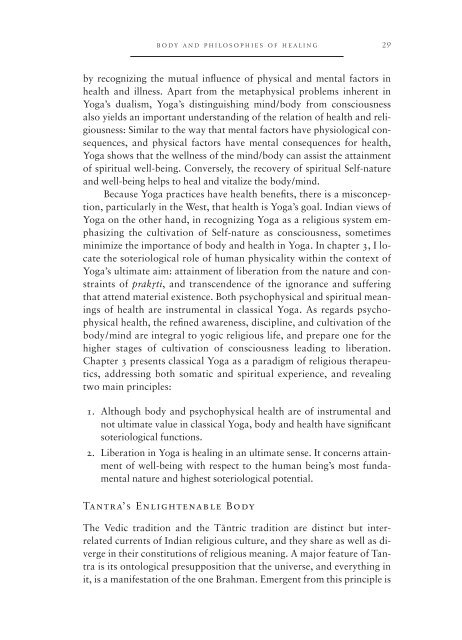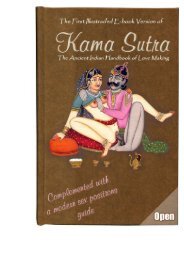body and health in yoga, Ayurveda, and Tantra
body and health in yoga, Ayurveda, and Tantra
body and health in yoga, Ayurveda, and Tantra
Create successful ePaper yourself
Turn your PDF publications into a flip-book with our unique Google optimized e-Paper software.
ody <strong>and</strong> philosophies of heal<strong>in</strong>g 29<br />
by recogniz<strong>in</strong>g the mutual <strong>in</strong>fluence of physical <strong>and</strong> mental factors <strong>in</strong><br />
<strong>health</strong> <strong>and</strong> illness. Apart from the metaphysical problems <strong>in</strong>herent <strong>in</strong><br />
Yoga’s dualism, Yoga’s dist<strong>in</strong>guish<strong>in</strong>g m<strong>in</strong>d/<strong>body</strong> from consciousness<br />
also yields an important underst<strong>and</strong><strong>in</strong>g of the relation of <strong>health</strong> <strong>and</strong> religiousness:<br />
Similar to the way that mental factors have physiological consequences,<br />
<strong>and</strong> physical factors have mental consequences for <strong>health</strong>,<br />
Yoga shows that the wellness of the m<strong>in</strong>d/<strong>body</strong> can assist the atta<strong>in</strong>ment<br />
of spiritual well-be<strong>in</strong>g. Conversely, the recovery of spiritual Self-nature<br />
<strong>and</strong> well-be<strong>in</strong>g helps to heal <strong>and</strong> vitalize the <strong>body</strong>/m<strong>in</strong>d.<br />
Because Yoga practices have <strong>health</strong> benefits, there is a misconception,<br />
particularly <strong>in</strong> the West, that <strong>health</strong> is Yoga’s goal. Indian views of<br />
Yoga on the other h<strong>and</strong>, <strong>in</strong> recogniz<strong>in</strong>g Yoga as a religious system emphasiz<strong>in</strong>g<br />
the cultivation of Self-nature as consciousness, sometimes<br />
m<strong>in</strong>imize the importance of <strong>body</strong> <strong>and</strong> <strong>health</strong> <strong>in</strong> Yoga. In chapter 3, I locate<br />
the soteriological role of human physicality with<strong>in</strong> the context of<br />
Yoga’s ultimate aim: atta<strong>in</strong>ment of liberation from the nature <strong>and</strong> constra<strong>in</strong>ts<br />
of prakÓrti, <strong>and</strong> transcendence of the ignorance <strong>and</strong> suffer<strong>in</strong>g<br />
that attend material existence. Both psychophysical <strong>and</strong> spiritual mean<strong>in</strong>gs<br />
of <strong>health</strong> are <strong>in</strong>strumental <strong>in</strong> classical Yoga. As regards psychophysical<br />
<strong>health</strong>, the ref<strong>in</strong>ed awareness, discipl<strong>in</strong>e, <strong>and</strong> cultivation of the<br />
<strong>body</strong>/m<strong>in</strong>d are <strong>in</strong>tegral to yogic religious life, <strong>and</strong> prepare one for the<br />
higher stages of cultivation of consciousness lead<strong>in</strong>g to liberation.<br />
Chapter 3 presents classical Yoga as a paradigm of religious therapeutics,<br />
address<strong>in</strong>g both somatic <strong>and</strong> spiritual experience, <strong>and</strong> reveal<strong>in</strong>g<br />
two ma<strong>in</strong> pr<strong>in</strong>ciples:<br />
1. Although <strong>body</strong> <strong>and</strong> psychophysical <strong>health</strong> are of <strong>in</strong>strumental <strong>and</strong><br />
not ultimate value <strong>in</strong> classical Yoga, <strong>body</strong> <strong>and</strong> <strong>health</strong> have significant<br />
soteriological functions.<br />
2. Liberation <strong>in</strong> Yoga is heal<strong>in</strong>g <strong>in</strong> an ultimate sense. It concerns atta<strong>in</strong>ment<br />
of well-be<strong>in</strong>g with respect to the human be<strong>in</strong>g’s most fundamental<br />
nature <strong>and</strong> highest soteriological potential.<br />
<strong>Tantra</strong>’s Enlightenable Body<br />
The Vedic tradition <strong>and</strong> the T¯antric tradition are dist<strong>in</strong>ct but <strong>in</strong>terrelated<br />
currents of Indian religious culture, <strong>and</strong> they share as well as diverge<br />
<strong>in</strong> their constitutions of religious mean<strong>in</strong>g. A major feature of <strong>Tantra</strong><br />
is its ontological presupposition that the universe, <strong>and</strong> everyth<strong>in</strong>g <strong>in</strong><br />
it, is a manifestation of the one Brahman. Emergent from this pr<strong>in</strong>ciple is



